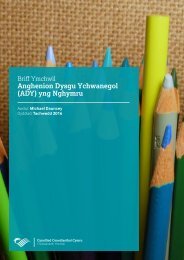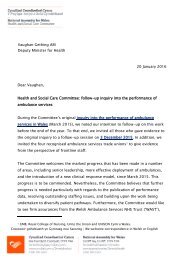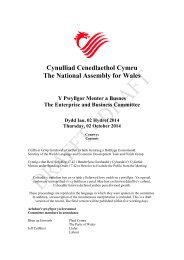Priorities for the future of Welsh Rail Infrastructure
cr-ld10657-e
cr-ld10657-e
Create successful ePaper yourself
Turn your PDF publications into a flip-book with our unique Google optimized e-Paper software.
However, NWEAB noted 44 that <strong>the</strong> Wales Route doesn’t coincide<br />
with rail traffic flows in north Wales, which are largely cross-border.<br />
There<strong>for</strong>e, NWEAB suggested that Network <strong>Rail</strong> Wales must<br />
develop cross-border links and co-ordinating arrangements that enable<br />
holistic planning <strong>for</strong> <strong>the</strong> North Wales network, to avoid fragmentation<br />
and under-investment caused by undertaking appraisals that stop at<br />
<strong>the</strong> border. A similar view is taken by <strong>the</strong> Wrexham – Birkenhead <strong>Rail</strong><br />
Users’ Association (WBRUA) who stated that Network <strong>Rail</strong> Routes could<br />
align better with rail corridors and traffic flows, ra<strong>the</strong>r than split <strong>the</strong>m.<br />
Unsurprisingly, given <strong>the</strong> national and international nature <strong>of</strong> <strong>the</strong><br />
business, <strong>the</strong> rail freight sector shares concerns about fragmentation<br />
as a result <strong>of</strong> devolution within Network <strong>Rail</strong>.<br />
DfT’s written evidence outlined Network <strong>Rail</strong>’s plans <strong>for</strong> “deeper<br />
devolution” within <strong>the</strong> organisation announced in 2015. This included<br />
<strong>the</strong> creation <strong>of</strong> a new Route Services Directorate (RSD) to enable routes<br />
to identify which services should be centrally provided, and which at<br />
route level. Additionally, Network <strong>Rail</strong> planning will divide into 8 units<br />
based on <strong>the</strong> current route structure to allow benchmarking and<br />
demonstrate that route services are competitive.<br />
Centralisation concerns<br />
ATW felt that <strong>the</strong> Wales Route is restricted by <strong>the</strong> funding<br />
allocated from Network <strong>Rail</strong> centrally. It also queried whe<strong>the</strong>r, as part<br />
<strong>of</strong> Network <strong>Rail</strong>’s route devolution, each route should have <strong>the</strong><br />
resources to deliver large scale infrastructure changes. If not, it<br />
believed that Wales would remain beholden to Network <strong>Rail</strong> central<br />
project teams <strong>for</strong> <strong>the</strong> delivery <strong>of</strong> critical <strong>Welsh</strong> projects. Similar<br />
concerns were raised by Pr<strong>of</strong>essor Stuart Cole:<br />
“On major projects managed by Wales and West Division <strong>the</strong><br />
management is not devolved […]The head <strong>of</strong> <strong>the</strong>…[Cardiff<br />
Areas Signalling Renewal] project does not report to <strong>the</strong> Wales<br />
route, but to <strong>the</strong> [Network <strong>Rail</strong>] Head Office. This also applies<br />
to [Newport Area Signalling Renewal] and <strong>the</strong> Port Talbot<br />
rebuilding. It is <strong>the</strong>re<strong>for</strong>e harder <strong>for</strong> <strong>the</strong> [<strong>Welsh</strong> Government] to<br />
control renewals and enhancements and harder <strong>for</strong> <strong>the</strong> major<br />
44<br />
Written evidence, NWEAB.<br />
38








